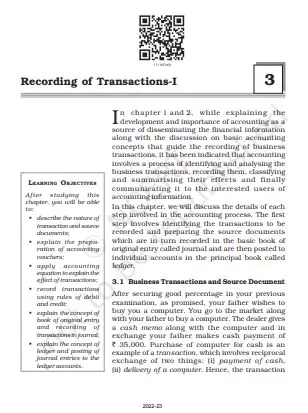‘NCERT Solutions for Class 11 Accountancy Chapter 3 Recording of Transactions 1‘ PDF Quick download link is given at the bottom of this article. You can see the PDF demo, size of the PDF, page numbers, and direct download Free PDF of ‘Recording of Transactions Notes’ using the download button.
Recording of Transactions 1 Textbook With Solution PDF Free Download

Chapter 3: Recording of Transactions 1
In chapters 1 and 2, while explaining the development and importance of accounting as a source of disseminating financial information along with the discussion on basic accounting concepts that guide the recording of business transactions,
It has been indicated that accounting involves a process of identifying and analyzing the business transactions, recording them, classifying and summarising their effects, and finally communicating them to the interested users of accounting information.
In this chapter, we will discuss the details of each step involved in the accounting process.
The first step involves identifying the transactions to be recorded and preparing the source documents which are in turn recorded in the basic book of original entry called journal and are then posted to individual accounts in the principal book called ledger.
3.1 Business Transactions and Source Document After securing good percentage in your previous examination, as promised, your father wishes to buy you a computer.
You go to the market along with your father to buy a computer. The dealer gives a cash memo along with the computer and in exchange your father makes cash payment of 35,000.
Purchase of computer for cash is an example of a transaction, which involves reciprocal exchange of two things: (i) payment of cash, (ii) delivery of a computer.
Hence, the transaction involves this aspect, i.e. Give and Take. Payment of cash involves give aspect and delivery of computer is a take aspect.
Thus, business transactions are exchanges of economic consideration between parties and have two-fold effects that are recorded in at least two accounts.
Business transactions are usually evidenced by an appropriate documents such as Cash memo, Invoice, Sales bill, Pay-in-slip, Cheque, Salary slip, etc. A document that provides evidence of the transactions is called the Source Document or a Voucher.
At times, there may be no documentary for certain items as in case of petty expenses. In such case voucher may be prepared showing the necessary details and got approved by appropriate authority within the firm.
All such documents (vouchers) are arranged in chronological order and are serially numbered and kept in a separate file.
All recording in books of account is done on the basis of vouchers. Accounting vouchers may be classified as cash vouchers, debit vouchers, credit vouchers, journal vouchers, etc.
There is no set format of accounting vouchers. A specimen of a simple transaction voucher is used in practice is shown in figure 3.1.
These must be preserved in any case till the audit of the accounts and tax assessments for the relevant period are completed.
Now a days, accounting is computerised and the necessary accounting vouchers showing the code number and name of the accounts to be debited and credited are prepared for the purpose of necessary recording of transactions.
A transaction with one debit and one credit is a simple transaction and the accounting vouchers prepared for such transaction is known as Transaction Voucher, the format of which is shown in figure 3.1.
Voucher which records a transaction that entails multiple debits/credits and one credit/debit is called compound voucher. Compound voucher may be: (a) Debit Voucher o7r (b) Credit Voucher; the specimen is shown in figure 3.2.
| Author | NCERT |
| Language | English |
| No. of Pages | 53 |
| PDF Size | 3.5 MB |
| Category | Accountancy |
| Source/Credits | ncert.nic.in |
NCERT Solutions Class 11 Accountancy Chapter 3 Recording of Transactions 1
1. State the three fundamental steps in the accounting process.
The fundamental steps of the accounting process are:
1. Identifying and analyzing the business transactions.
2. Recording of the business transactions.
3. Classifying and summarizing their effect and communicating the same to the interested users of business information.
2. Why is the evidence provided by source documents important to accounting?
The importance of source documents in accounting is due to the following reasons:
1. It provides evidence of the transaction that has taken place.
2. It acts as a backup in times of auditing and tax assessment
3. It acts as primary legal evidence as journal entries are based on data from source documents.
3. Should a transaction be first recorded in a journal or ledger? Why?
The practice of recording a transaction in the journal in the first instance provides for a complete record of each transaction and also keeps a track of all debits and credits related to each transaction.
4. Are debits or credits listed first in journal entries? Are debits or credits indented?
Debit gets recorded in the journal first before credit, but both debit and credit are recorded into the journal before being recorded in the ledger.
Debit entry is recorded without any margin, indent, or spacing. However, for a credit entry some spacing, margin, or indent is essential. The symbol Dr. is for debit entry is right aligned.
Accounting systems are called double accounting systems as they have two aspects to each transaction. Every transaction is recorded on the debit and credit sides simultaneously.
Recording Of Transactions Part 2 NCERT PDF
NCERT Class 11 Accountancy Textbook Chapter 3 Recording of Transactions With Answer PDF Free Download
